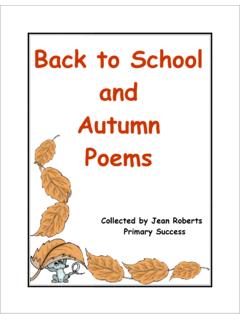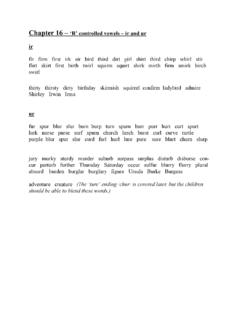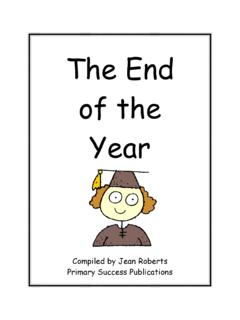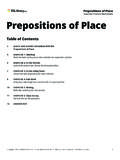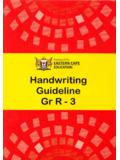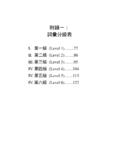Transcription of Printing Letters Correctly - Primary Success …
1 Printing Letters Correctly The ball and stick method of teaching beginners to print has been proven to be the best. Letters formed this way are easier for small children to print, and this print is similar to the print they will see in beginner reading books. The ball is started at the top center, and is drawn to the left (counter-clockwise). The stick is drawn from the top on a line down to a line. As children s writing matures, they will begin to make Letters such as a and d without lifting the pencil . I have given you both methods for these Letters . Young children need guide lines for Printing , or it will wobble all over the page.
2 The inter-lined paper is best - this has a dotted line between the solid lines. Some teachers talk about a house - where Letters stand on the floor and have their heads touch the ceilings. Some Letters live downstairs, some are tall and need both the downstairs and upstairs, and some have tails that go into the base-ment. When they are Printing words, the Letters should be almost touching each other in the word, and then room for a finger-space between words. Learning to print Correctly is important. Letters should always be formed from the top down, and touch the lines.
3 For the lower case a, the children begin at the top of the ball and go to the left to make a circle. The pencil is then lifted and the straight line is made from top to bottom just touching the ball. Tell the children to begin by putting the pencil on the dots. For the upper case A, the tall line on the left is made first, beginning at the top, the tall right line is the second step, also beginning at the top, and the horizontal line is last, drawn from left to right on the dotted line. More mature students will make the lower case a by starting the circle below the line, circling to the left touching the dotted line and the base line and then coming straight up to the dotted line and then making the straight line down over the up-stroke without taking the pencil point off the paper.
4 The ball must be closed. To form the lower case b, first draw the vertical line, top to bottom. Then lift the pencil and put the pencil point on the dots where the top of the circle will be, and draw the circle, left to right. A 'bat and a ball. To form the upper case B, make the vertical line first and then put the pencil point at the top of the vertical line again. Make the round top, joining the vertical line at the dots and then again at the floor. More mature students will make the lower case b by starting at the top of the vertical line and drawing it to the base and then stop - reverse as the line goes up fol-lowing the first and then going right over the top to make the ball by touching the dotted line and then around to the base and close to the vertical line.
5 A/A b/B Lower case c begins below the line and then the line touches the top, makes part of a ball (or oval if you wish), touches the floor and up slightly. Upper case C is formed the same way as the lower case. The lower case d is made in the same way as an a with a tall vertical line made from the top down. To make the upper case D the vertical line is drawn first top to bottom, then the pencil is placed back on the start-ing point and the curve is drawn to the floor. More mature students will make the lower case d by starting the circle below the line, circling to the left touching the dotted line and the base line and then coming straight up to the top line and then making the straight line down over the up-stroke without taking the pencil point off the paper.
6 The ball must be closed. The lower case e begins with a straight line in the center of the space, left to right, stop - then around the circle touching the dotted line, the beginning point and the floor. The upper case E begins with the vertical line, top to bot-tom. The horizontal lines are made top to bottom and left to right. The lower case f begins below the line, and it touches the top line. The stem is a straight line. The cross stroke is made left to right. The upper case F begins with the vertical straight line, top to bottom, the top horizontal line is made next, and then the center horizontal line, both made left to right.
7 C/C d/D e/E f/F To form the lower case g, make the ball first, beginning at the top and drawing to the left. Then make the vertical line beginning at the dots, down to the line below and curving up-wards. The upper case G is like the C with a straight horizontal line inwards on the dotted line, made continuously. More mature students will make the lower case g by start-ing the circle below the line, circling to the left touching the dotted line and the base line and then coming straight up to the dotted line and then making the straight line down over the up-stroke (as in making the a ) and going down to the line below and a half-circle to the left without taking the pencil point off the paper.
8 The ball must be closed. The lower case h is made without lifting the pencil . Begin at the top to make the vertical line, stop at the floor, back up the vertical line to round over at the dots and straight down to the base line. The upper case H is formed by making the two vertical lines first, and then connecting them from left to right on the dotted line. (Reverse 2 and 3 in the ) The lower case i is simple, one short straight line drawn from the dotted line downwards. The dot is just that, a tiny pencil mark in the center of the space, directly above the line. The upper case I is a straight line drawn from the top downwards.
9 Have the children put two tiny lines (left to right) at the top and bottom of the vertical line. g/G h/H i I The lower case j is formed as the i. Make a vertical line beginning at the dots, down through the floor and curl to the left at the dotted line below. Make a tiny dot above. The upper case J begins at the top. To form the lower case k, first make the vertical line from top to bottom, then the upper diagonal begins at the dots and goes to the vertical line. Then last is the lower diagonal, both from the highest end of the line to the lowest.
10 The upper case K is formed in the same way, with three separate lines all drawn from top to bottom. The lower case l is simply a straight line drawn from top to bottom. The upper case L begins at the top and is made with one continuous line, vertical and horizontal. The lower case M is made without lifting the pencil point. It begins at the dotted line, goes down and back up the same line and then around at the top. The line then goes straight down to the floor, back up the same line and over touching the dotted line and then straight down. The upper case M begins at the top of the left vertical line and it is drawn to the floor.

